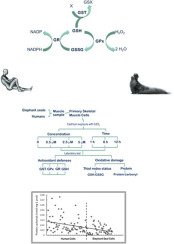当前位置:
X-MOL 学术
›
Comp. Biochem. Physiol. C Toxicol. Pharmacol.
›
论文详情
Our official English website, www.x-mol.net, welcomes your feedback! (Note: you will need to create a separate account there.)
Antioxidant response to cadmium exposure in primary skeletal muscle cells isolated from humans and elephant seals.
Comparative Biochemistry and Physiology C: Toxicology & Pharmacology ( IF 3.9 ) Pub Date : 2019-10-22 , DOI: 10.1016/j.cbpc.2019.108641 Adriana C Del Águila-Vargas 1 , José Pablo Vázquez-Medina 2 , Daniel E Crocker 3 , Lía C Méndez-Rodríguez 1 , Ramón Gaxiola-Robles 4 , Juan A de Anda-Montañez 1 , Luis Javier Ramírez-Jirano 5 , Orlando Lugo-Lugo 1 , Tania Zenteno-Savín 1
Comparative Biochemistry and Physiology C: Toxicology & Pharmacology ( IF 3.9 ) Pub Date : 2019-10-22 , DOI: 10.1016/j.cbpc.2019.108641 Adriana C Del Águila-Vargas 1 , José Pablo Vázquez-Medina 2 , Daniel E Crocker 3 , Lía C Méndez-Rodríguez 1 , Ramón Gaxiola-Robles 4 , Juan A de Anda-Montañez 1 , Luis Javier Ramírez-Jirano 5 , Orlando Lugo-Lugo 1 , Tania Zenteno-Savín 1
Affiliation

|
Cadmium (Cd) occurs naturally; however, its concentration can increase with anthropogenic activities. Excess Cd increases reactive oxygen species (ROS) production and oxidative damage, which can lead to pathological conditions. Marine mammals accumulate Cd in the liver and the kidney; yet, there are no reports of Cd-associated tissue damage in whales, seals or dolphins. Response to Cd exposure (0-5.0 μM CdCl2 for 1-12 h) was analyzed and compared in primary skeletal muscle cells isolated from northern elephant seals (Mirounga angustirostris) and humans (Homo sapiens). Antioxidant enzyme activities (glutathione S-transferase, glutathione reductase, glutathione peroxidase), glutathione concentration, and protein carbonyl levels (an indicator of oxidative damage) were quantified. Glutathione levels were higher in northern elephant seal than in human cells. Protein carbonyl content in cells exposed to Cd was lower and had a smaller variability range in elephant seals than in humans. Generalized linear models (GLIM) identified Cd exposure and antioxidant defenses as significant contributors to protein carbonyl variability in human but not in elephant seal cells. These results suggest that the previously observed differences in circulating and tissue glutathione levels between marine and terrestrial mammals are maintained under cell culture conditions and that northern elephant seal and human muscle cells respond differently to Cd exposure. The results also suggest that the observed differences could potentially be associated with the protective mechanisms that allow northern elephant seals to tolerate extreme conditions that result in increased ROS generation (e.g. diving, sleep apnea, fasting) with no oxidative damage.
中文翻译:

从人体和海象中分离出的骨骼肌细胞对镉暴露的抗氧化反应。
镉(Cd)自然产生;但是,其浓度会随着人为活动而增加。过量的镉会增加活性氧(ROS)的产生和氧化损伤,从而导致病理状况。海洋哺乳动物在肝脏和肾脏中积累了镉。但是,尚无鲸,海豹或海豚中与镉相关的组织损伤的报道。在从北方象海豹(Mirounga angustirostris)和人类(智人)分离的初级骨骼肌细胞中,分析并比较了对Cd暴露(0-5.0μMCdCl2持续1-12 h)的反应。定量抗氧化酶活性(谷胱甘肽S-转移酶,谷胱甘肽还原酶,谷胱甘肽过氧化物酶),谷胱甘肽浓度和蛋白质羰基水平(氧化损伤的指标)。北部象海豹中的谷胱甘肽水平高于人类细胞。与人类相比,暴露在镉中的细胞中的蛋白质羰基含量更低,并且在海象中具有较小的变异范围。广义线性模型(GLIM)将Cd暴露和抗氧化防御机制确定为对人体内蛋白质羰基变异性的重要贡献,而对象海豹细胞则没有。这些结果表明,在细胞培养条件下,海洋和陆地哺乳动物之间循环和组织谷胱甘肽水平的先前观察到的差异得以维持,而北象海豹和人类肌肉细胞对Cd暴露的反应不同。
更新日期:2019-10-22
中文翻译:

从人体和海象中分离出的骨骼肌细胞对镉暴露的抗氧化反应。
镉(Cd)自然产生;但是,其浓度会随着人为活动而增加。过量的镉会增加活性氧(ROS)的产生和氧化损伤,从而导致病理状况。海洋哺乳动物在肝脏和肾脏中积累了镉。但是,尚无鲸,海豹或海豚中与镉相关的组织损伤的报道。在从北方象海豹(Mirounga angustirostris)和人类(智人)分离的初级骨骼肌细胞中,分析并比较了对Cd暴露(0-5.0μMCdCl2持续1-12 h)的反应。定量抗氧化酶活性(谷胱甘肽S-转移酶,谷胱甘肽还原酶,谷胱甘肽过氧化物酶),谷胱甘肽浓度和蛋白质羰基水平(氧化损伤的指标)。北部象海豹中的谷胱甘肽水平高于人类细胞。与人类相比,暴露在镉中的细胞中的蛋白质羰基含量更低,并且在海象中具有较小的变异范围。广义线性模型(GLIM)将Cd暴露和抗氧化防御机制确定为对人体内蛋白质羰基变异性的重要贡献,而对象海豹细胞则没有。这些结果表明,在细胞培养条件下,海洋和陆地哺乳动物之间循环和组织谷胱甘肽水平的先前观察到的差异得以维持,而北象海豹和人类肌肉细胞对Cd暴露的反应不同。



























 京公网安备 11010802027423号
京公网安备 11010802027423号